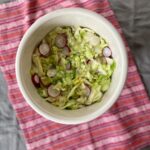
Sauerkraut with leeks, radish, and black pepper
This sauerkraut shouts springtime. It's earthy, sharp, and nuanced. After a long fermentation of 21 days (or more), the flavors mellow and digestive benefits increase.
Equipment
- Bus tub
- 1 gallon canning jar or ceramic crock
- Fermentation weight
Instructions
Day 1
- Wash all your vegetables, bus tub, and fermentation container(s).
- Chop the cabbage, leeks, and radishes. Put them all in a bus tub and add sea salt.
- Massage the salt in with your hands for a couple of minutes. Set aside for 30-60 minutes. Add black pepper. Taste and add more black pepper as desired.
- Pack the sauerkraut mixture, including the liquid that has been released, into a jar or crock. Firmly pack down the cabbage mixture and place your weight.
- Pack the sauerkraut mixture, including the liquid that has been released, into a jar or crock. Firmly pack down the cabbage mixture and place your weight. Cover the top of the jar with a flour sack towel.
- Set the sauerkraut in a cool spot away from direct sunlight.
Day 2
- Check the brine. It may have increased overnight. If it does, pour off extra brine so that it doesn’t overflow. Check it again later in the day to make sure the brine didn’t rise back up. Pour off any extra.
- Give it a visual check every day.
Day 3
- Expect to see bubbles rising up through the brine and maybe foam on top.
- Give it a visual check every day.
Day 7-21
- You may notice less activity and no foam or bubbles. This is normal!
- Give it a try to see how you like it. More time = more tang. If you want it to keep fermenting longer, place everything back under the brine and keep it at room temp for a few more days.
For storage
- Once fermented to your liking, put a label on the jar with the name and date of your ferment. Top the jar with a plastic lid and place it in the fridge.
Notes
Skip black pepper and add some fresh thyme or rosemary. Let your taste buds guide you.
Use a fermentation weight. These sit right on top of the vegetables to keep the veggies underneath the brine. They’re a simple and non-toxic way to do fermentation at home. You can also use a fermentation device, like Kraut Source. It pushes down on the vegetables to make sure they stay beneath their brine.
Watch for signs of fermentation. This usually starts on day 2 and peaks on day 3. You might see foam at the top or bubbles rippling through the brine. This is a good sign! It means healthy bacteria are there doing their job.
Save the brine. For a potent probiotic punch, sip the brine with lunch or use it to replace the vinegar in your favorite salad dressing.